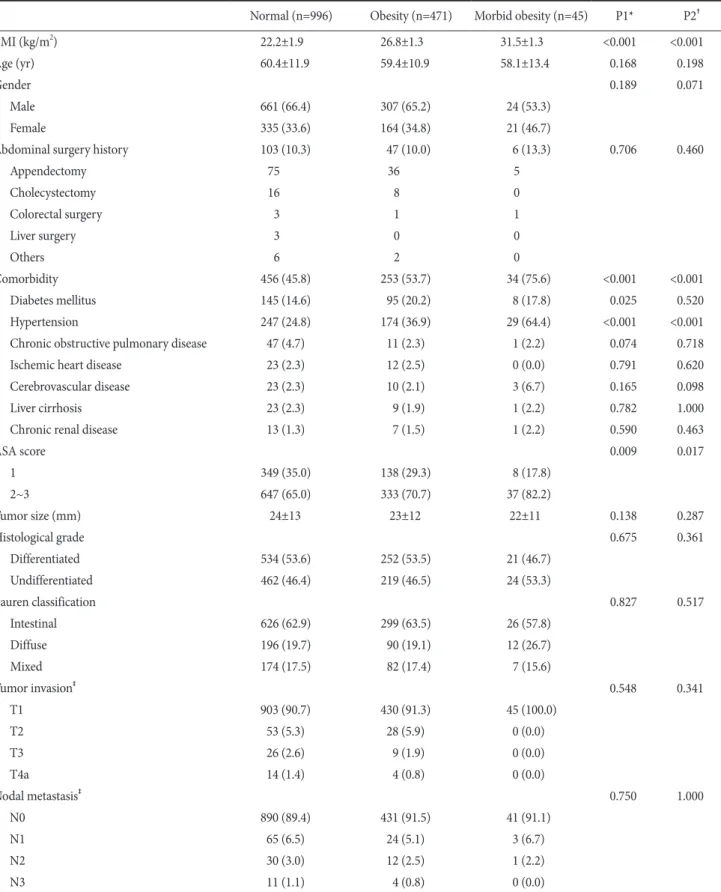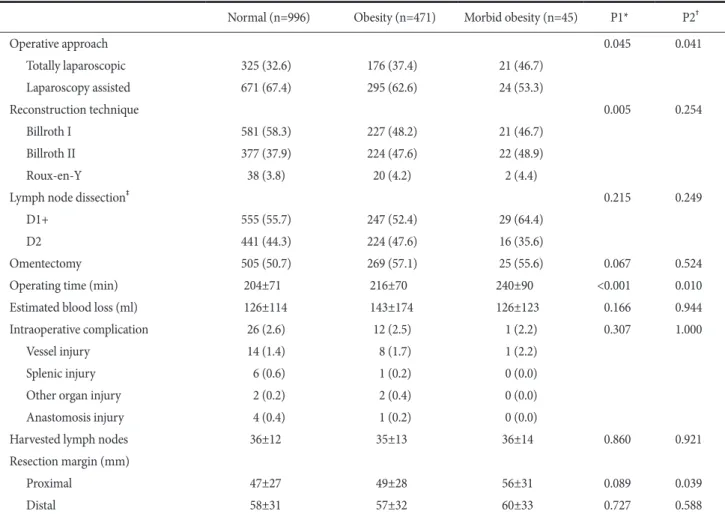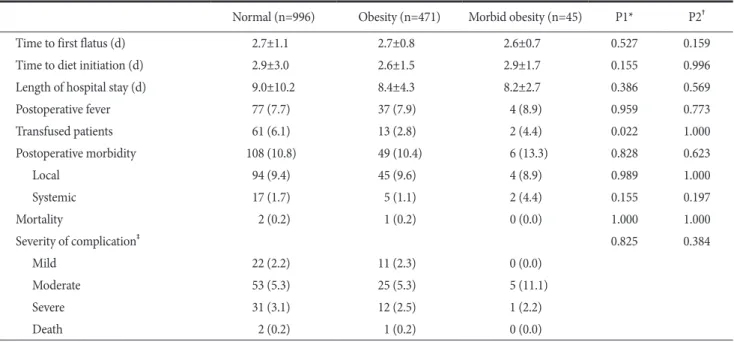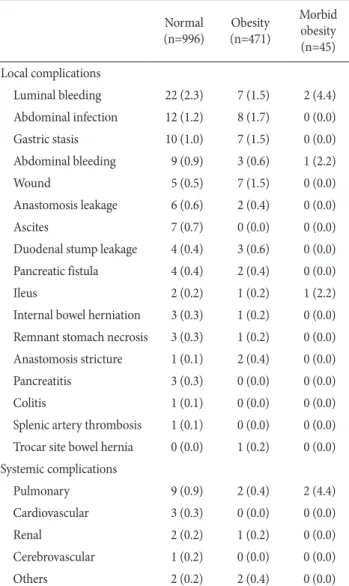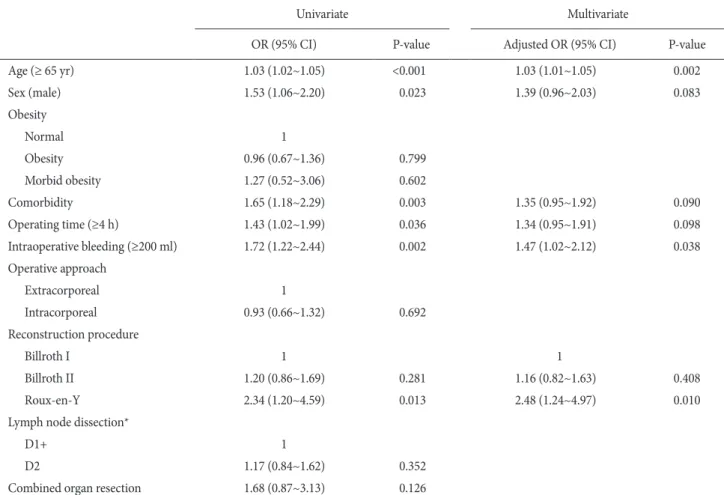Laparoscopic Distal Gastrectomy for Gastric Cancer in Morbidly Obese Patients in South Korea
Ji Hoon Jung, Seong Yeop Ryu, Mi Ran Jung, Young Kyu Park, and Oh Jeong
Division of Gastroenterologic Surgery, Department of Surgery, Chonnam National University Hwasun Hospital, Hwasun, Korea
Purpose: Laparoscopic gastrectomy in obese patients has been investigated in several studies, but its feasibility has rarely been exam- ined in morbidly obese patients, such as in those with a body mass index (BMI) of ≥30 kg/m2. The present study aimed to evaluate the technical feasibility and safety of laparoscopic gastrectomy in morbidly obese patients with gastric cancer.
Materials and Methods: A total of 1,512 gastric cancer patients who underwent laparoscopic distal gastrectomy (LDG) were divided into three groups: normal (BMI<25 kg/m2, n=996), obese (BMI 25~30 kg/m2, n=471), and morbidly obese (BMI≥30 kg/m2, n=45).
Short-term surgical outcomes, including the course of hospitalization and postoperative complications, were compared between the three groups.
Results: The morbidly obese group had a significantly longer operating time (240 minutes vs. 204 minutes, P=0.010) than the normal group, but no significant differences were found between the groups with respect to intraoperative blood loss or other complications. In the morbidly obese group, the postoperative morbidity and mortality rates were 13.3% and 0%, respectively, and the mean length of hospital stay was 8.2 days, which were not significantly different from those in the normal group. Subgroup analysis showed that post- operative complication rates were not high in morbidly obese patients, independent of the type of anastomosis technique used and level of lymph node dissection.
Conclusions: LDG is technically feasible and safe in morbidly obese patients with a BMI of ≥30 kg/m2 and early gastric carcinoma. Ex- cept for a longer operating time, LDG might represent a reasonable treatment option in these patients.
Key Words: Stomach neoplasms; Laparoscopy; Gastrectomy; Morbid obesity; Morbidity
Correspondence to: Oh Jeong
Division of Gastroenterologic Surgery, Department of Surgery, Chonnam National University Hwasun Hospital, 322 Seoyang-ro, Hwasun-eup, Hwasun-gun, Hwasun 519-763, Korea
Tel: +82-61-379-7646, Fax: +82-61-379-7661 E-mail: surgeonjeong@gmail.com
Received August 11, 2014 Revised September 5, 2014 Accepted September 6, 2014
Copyrights © 2014 by The Korean Gastric Cancer Association www.jgc-online.org
This is an open-access article distributed under the terms of the Creative Commons Attribution Non-Commercial License (http://creativecommons.org/
licenses/by-nc/3.0) which permits unrestricted noncommercial use, distribution, and reproduction in any medium, provided the original work is properly cited.
Introduction
In Korea and Japan, the implementation of a nationwide sur- veillance program for the early detection of gastric carcinoma has resulted in a widespread acceptance of laparoscopic gastrectomy (LG) as a valid alternative to open surgery, for the treatment of early gastric cancer (EGC).1 Clinical advantages of LG over open
surgery, including better cosmesis, less pain, faster bowel recovery, reduced hospital stay, lower morbidity, and improved short-term quality of life, have been reported in several studies.2-4 Furthermore, the long term outcomes of LG for EGC are comparable to those of open surgery, with a 5-year survival rate exceeding 98%.5
Obesity is regarded as a major technical limiting factor for LG, because of the substantial operative difficulties caused by the abun- dant visceral fat and a narrow operating field. However, increas- ingly advanced surgeon skills and laparoscopic instrument develop- ment have facilitated the conduction of studies designed to address the technical feasibility of LG in obese patients.6-11 Although the majority of these studies have concluded that LG is technically fea- sible and safe in obese patients with lower body mass indexs (BMIs) of ≥23 to ≥25 kg/m2, little information exist on the technical
feasibility and safety of LG in morbidly obese patients (BMI of ≥ 30 kg/m2).12,13 In the present study, we aimed to evaluate the short- term surgical outcomes of laparoscopic distal gastrectomy (LDG) in morbidly obese patients (BMI of ≥30 kg/m2) with gastric carci- noma.
Materials and Methods
1. Patients
Between January 2006 and September 2012, 1,532 patients un- derwent LDG for gastric carcinoma at our institute. Twenty patients who underwent combined surgery because of a concomitant malig- nancy were excluded, and the remaining 1,512 patients were retro- spectively enrolled in the present study. The indication for LDG at our institution was a mucosal or submucosal cancer without lymph node metastasis (cT1N0) which was unsuitable for endoscopic re- section. Some patients with advanced gastric cancer (cT2-3N0 or cN1-2) were subjected to laparoscopic surgery only for clinical trial purposes (ClinicalTrials.gov, NCT01088204). Preoperative work-up included esophagogastroduodenoscopy with biopsy and abdomino- pelvic computed tomography (CT). Electrocardiography, chest ra- diography, spirometry, and blood analysis were routinely performed for all patients. Endoscopic ultrasonography, magnetic resonance imaging, or chest CT was performed in selected patients for tumor staging. Patients were divided into three obesity groups: a normal group (BMI<25 kg/m2), an obese group (BMI 25~30 kg/m2), and a morbidly obese group (BMI≥30 kg/m2) according to the World Health Organization definition of obesity in the Asia-Pacific re- gion.
Using the hospital prospective patient data registry, the follow- ing parameters were retrospectively collected: age, sex, abdominal surgery history, comorbidities, American Society of Anesthesiolo- gists (ASA) physical status, pathology results, surgical procedures, operating time, intraoperative blood loss, intraoperative complica- tions, postoperative course (time to flatus, time to diet initiation, and length of hospital stay), and postoperative complications. The amount of intraoperative blood loss was estimated by measuring the weight of blood-soaked surgical gauzes used during the opera- tion. A postoperative complication was defined as any event that resulted in a deviation of the normal recovery phase necessitating medical or surgical intervention. A complication associated with the operating field was considered a local complication, and others were regarded as systemic. Complication severity was recorded as described by the Accordion Severity Grading System of Surgical
Complications.14 Pathological tumor staging was based on the tu- mor-node-metastasis (TNM) classification system as described in the seventh edition of the Union for International Cancer Control.15
2. Operative technique
All operations were performed by three experienced surgeons.
Briefly, with the patient in the reverse Trendelenburg position, two operator ports were placed on the patient’s right side, two assistant ports on the left, and one umbilical port placed for laparoscope insertion. The liver was retracted upward through an additional 5-mm port placed at the epigastrium or by using a simple suturing technique. Under pneumoperitoneum at an insufflation pressure of 12 to 14 mmHg, the procedure began with the division of the greater omentum, 3 cm from the gastroepiploic vessels, and then moved toward the left gastroepiploic area. Lymph node dissection (LND) was performed as described in the Japanese Classification of Gastric Carcinoma (3rd English edition).16 In the present study, D1+LND refers to excision of perigastric lymph nodes and num- ber 7, 8a, and 9 lymph nodes, and D2 LND refers to excision of perigastric lymph nodes and number 7, 8a, 9, 11p, and 12a lymph nodes. All gastric and LNDs were performed using LigaSureTM (LF5544; Valley Labs, Boulder, CO, USA) or a harmonic scalpel (ACE 36E; Ethicon Endo-Surgery, Cincinnati, OH, USA) as ap- propriate. After completing the gastric dissection, either intra- or extracorporeal anastomosis was performed at the surgeon’s discre- tion. For extracorporeal anastomosis, a 4 to 5 cm upper midline abdominal incision was made, and the Billroth I reconstruction performed by externalization of the stomach through the incision.
For intracorporeal anastomosis, the Billroth II method, performed using an endoscopic linear stapler, was the primary choice for re- construction.
3. Statistical analysis
All the results are presented as means±standard deviations for continuous variables or as numbers and percentages for categori- cal variables. The three groups were compared with respect to clinicopathological characteristics, surgical outcomes, course of hospitalization, morbidity, and mortality, using one-way analysis of variance (ANOVA) or the chi-square test. The Student’s t test or the chi-square test was used to compare surgical outcomes in the morbidly obese and normal groups. In addition, to determine the risks posed by morbid obesity on the different types of surgical procedure, a logistic regression analysis model was used to calculate the odds ratios of postoperative complications. The analysis was
Table 1. Baseline characteristics in the three BMI groups
Normal (n=996) Obesity (n=471) Morbid obesity (n=45) P1* P2†
BMI (kg/m2) 22.2±1.9 26.8±1.3 31.5±1.3 <0.001 <0.001
Age (yr) 60.4±11.9 59.4±10.9 58.1±13.4 0.168 0.198
Gender 0.189 0.071
Male 661 (66.4) 307 (65.2) 24 (53.3)
Female 335 (33.6) 164 (34.8) 21 (46.7)
Abdominal surgery history 103 (10.3) 47 (10.0) 6 (13.3) 0.706 0.460
Appendectomy 75 36 5
Cholecystectomy 16 8 0
Colorectal surgery 3 1 1
Liver surgery 3 0 0
Others 6 2 0
Comorbidity 456 (45.8) 253 (53.7) 34 (75.6) <0.001 <0.001
Diabetes mellitus 145 (14.6) 95 (20.2) 8 (17.8) 0.025 0.520
Hypertension 247 (24.8) 174 (36.9) 29 (64.4) <0.001 <0.001
Chronic obstructive pulmonary disease 47 (4.7) 11 (2.3) 1 (2.2) 0.074 0.718
Ischemic heart disease 23 (2.3) 12 (2.5) 0 (0.0) 0.791 0.620
Cerebrovascular disease 23 (2.3) 10 (2.1) 3 (6.7) 0.165 0.098
Liver cirrhosis 23 (2.3) 9 (1.9) 1 (2.2) 0.782 1.000
Chronic renal disease 13 (1.3) 7 (1.5) 1 (2.2) 0.590 0.463
ASA score 0.009 0.017
1 349 (35.0) 138 (29.3) 8 (17.8)
2~3 647 (65.0) 333 (70.7) 37 (82.2)
Tumor size (mm) 24±13 23±12 22±11 0.138 0.287
Histological grade 0.675 0.361
Differentiated 534 (53.6) 252 (53.5) 21 (46.7)
Undifferentiated 462 (46.4) 219 (46.5) 24 (53.3)
Lauren classification 0.827 0.517
Intestinal 626 (62.9) 299 (63.5) 26 (57.8)
Diffuse 196 (19.7) 90 (19.1) 12 (26.7)
Mixed 174 (17.5) 82 (17.4) 7 (15.6)
Tumor invasion‡ 0.548 0.341
T1 903 (90.7) 430 (91.3) 45 (100.0)
T2 53 (5.3) 28 (5.9) 0 (0.0)
T3 26 (2.6) 9 (1.9) 0 (0.0)
T4a 14 (1.4) 4 (0.8) 0 (0.0)
Nodal metastasis‡ 0.750 1.000
N0 890 (89.4) 431 (91.5) 41 (91.1)
N1 65 (6.5) 24 (5.1) 3 (6.7)
N2 30 (3.0) 12 (2.5) 1 (2.2)
N3 11 (1.1) 4 (0.8) 0 (0.0)
Values are presented as mean±standard deviation, number (%), or number only. BMI = body mass index; ASA = American Society of Anesthesiologists. *P1-values contained after comparison between the three BMI groups. †P2-values between the normal and morbidly obese groups. ‡Tumor stages are based on in the TNM classification system from the 7th edition of the Union for International Cancer Control/American Joint Committee on Cancer.
carried out using the SPSS software, version 12.0 for Windows (SPSS Inc., Chicago, IL, USA), and P-values of <0.05 were considered statistically significant throughout.
Results
Baseline characteristics of the three obesity groups are sum- marized in Table 1. The study subjects consisted of 992 males and 520 females with a mean age of 60.0 years. Among all patients, 996 (68.9%) were in the normal group, 471 (27.6%) in the obese group, and 45 (3.0%) in the morbidly obese group. Mean BMIs in these three groups were 22.2±1.9, 26.8±1.3, and 31.5±1.3 kg/m2, re- spectively. The patients’ distribution across TNM stages was as fol- lows: 1,406 (93.0%) stage I, 78 (5.2%) stage II, and 28 (1.9%) stage III.
Intergroup comparisons showed that the morbidly obese group had a significantly higher underlying comorbidity rate (75.6% vs.
45.8%, P<0.001) and a higher ASA score (ASA≥2, 82.2% vs.
65.0%, P=0.017) than the normal group. However, no significant intergroup differences were found between the three groups, with respect to age, gender, or abdominal surgery history. Pathological examination revealed no significant differences in the extent of tu- mor invasion or lymph node metastasis between the three groups.
1. Operative results
Intracorporeal or extracorporeal anastomoses were performed in 522 (34.5%) and 990 (65.5%) patients, respectively. The Billroth I, Billroth II, and Roux-en Y reconstructions were performed in 829 (54.8%), 623 (41.2%), and 60 (4.0%) patients, respectively. Among all patients, 831 underwent D1+LND and 681 underwent D2 LND.
Table 2 shows details of the operative results in the three obe- sity groups. The morbidly obese group underwent intracorporeal anastomosis more frequently (46.7% vs. 32.6%, P=0.041) than the normal group, but no significant differences were found in the
Table 2. Operative results in the three body mass index groups
Normal (n=996) Obesity (n=471) Morbid obesity (n=45) P1* P2†
Operative approach 0.045 0.041
Totally laparoscopic 325 (32.6) 176 (37.4) 21 (46.7)
Laparoscopy assisted 671 (67.4) 295 (62.6) 24 (53.3)
Reconstruction technique 0.005 0.254
Billroth I 581 (58.3) 227 (48.2) 21 (46.7)
Billroth II 377 (37.9) 224 (47.6) 22 (48.9)
Roux-en-Y 38 (3.8) 20 (4.2) 2 (4.4)
Lymph node dissection‡ 0.215 0.249
D1+ 555 (55.7) 247 (52.4) 29 (64.4)
D2 441 (44.3) 224 (47.6) 16 (35.6)
Omentectomy 505 (50.7) 269 (57.1) 25 (55.6) 0.067 0.524
Operating time (min) 204±71 216±70 240±90 <0.001 0.010
Estimated blood loss (ml) 126±114 143±174 126±123 0.166 0.944
Intraoperative complication 26 (2.6) 12 (2.5) 1 (2.2) 0.307 1.000
Vessel injury 14 (1.4) 8 (1.7) 1 (2.2)
Splenic injury 6 (0.6) 1 (0.2) 0 (0.0)
Other organ injury 2 (0.2) 2 (0.4) 0 (0.0)
Anastomosis injury 4 (0.4) 1 (0.2) 0 (0.0)
Harvested lymph nodes 36±12 35±13 36±14 0.860 0.921
Resection margin (mm)
Proximal 47±27 49±28 56±31 0.089 0.039
Distal 58±31 57±32 60±33 0.727 0.588
Values are presented as number (%) or mean±standard deviation. *P1-values between the three obesity groups. †P2-values between the normal and morbidly obese group. ‡According to the Japanese classification of gastric carcinoma.16
extent of LND or omentectomy between the three groups. The morbidly obese group showed a significantly longer operating time than the normal group (240 minutes vs. 204 minutes, P=0.010), but intraoperative blood loss, intraoperative complications, and number of lymph nodes harvested were similar between the three groups.
2. Course of hospitalization and postoperative morbidity
Among all study subjects, the morbidity and mortality rates were 10.8% and 0.2%, respectively, and the mean length of hospital stay was 8.8±8.6 days (Table 3). Morbidity and mortality rates in the morbidly obese group were 13.3% and 0%, respectively, and not significantly different from those in the normal group. There were no significant differences in time to first flatus or time to diet initiation between the three groups. The lengths of hospital stay were also similar between the three groups (9.0 days in the normal group, 8.4 days in the obese group, and 8.2 days in the morbidly obese group, P=0.380).
Table 4 provides details of postoperative complications that oc- curred in the three obesity groups. Among all study subjects, the most common complication was luminal bleeding (2.1%), followed by abdominal infection (1.3%), gastric stasis (1.1%), abdominal bleeding (0.9%), and wound complications (0.8%). The rates of each complication were not significantly different between the three groups.
Table 5 represents univariate and multivariate analyses of risk factors for postoperative morbidity. In univariate analysis, old age, male gender, comorbidity, operating time, intraoperative bleeding, and Roux-en Y reconstruction were significantly associated with the development of postoperative complications after LDG, while obesity was not. Multivariate analysis revealed that older age, intra- operative bleeding, and Roux-en-Y reconstruction were indepen- dent risk factors for postoperative complications after LDG.
3. Subgroup analysis of operative risk by morbid obesity
Fig. 1 shows the effect of morbid obesity on the risk of postop- erative complications (expressed as odds ratios) in different patient subgroups classified according to the types of operative procedure (omentectomy, LND, or reconstruction procedure) and demo- graphic features (age and gender). The results showed that morbid obesity did not increase the risk of postoperative complications in any of the subgroups.
Discussion
Obesity is often regarded as a challenging problem for many surgeons who perform gastric cancer operations.17-19 Studies inves- tigating the technical safety and feasibility of LG have been facili- tated by an increasingly higher level of LG skills among surgeons.
Table 3. Postoperative outcomes in the three body mass index groups
Normal (n=996) Obesity (n=471) Morbid obesity (n=45) P1* P2†
Time to first flatus (d) 2.7±1.1 2.7±0.8 2.6±0.7 0.527 0.159
Time to diet initiation (d) 2.9±3.0 2.6±1.5 2.9±1.7 0.155 0.996
Length of hospital stay (d) 9.0±10.2 8.4±4.3 8.2±2.7 0.386 0.569
Postoperative fever 77 (7.7) 37 (7.9) 4 (8.9) 0.959 0.773
Transfused patients 61 (6.1) 13 (2.8) 2 (4.4) 0.022 1.000
Postoperative morbidity 108 (10.8) 49 (10.4) 6 (13.3) 0.828 0.623
Local 94 (9.4) 45 (9.6) 4 (8.9) 0.989 1.000
Systemic 17 (1.7) 5 (1.1) 2 (4.4) 0.155 0.197
Mortality 2 (0.2) 1 (0.2) 0 (0.0) 1.000 1.000
Severity of complication‡ 0.825 0.384
Mild 22 (2.2) 11 (2.3) 0 (0.0)
Moderate 53 (5.3) 25 (5.3) 5 (11.1)
Severe 31 (3.1) 12 (2.5) 1 (2.2)
Death 2 (0.2) 1 (0.2) 0 (0.0)
Values are presented as mean±standard deviation or number (%). *P1-values between the three groups. †P2-values between the normal and morbidly obese group. ‡Based on the Accordion classification of the severity of complications.
Most of these studies have been conducted in obese patients, but the feasibility of LG in morbidly obese patients with a BMI of ≥30 kg/m2, has been rarely examined. In the present study, we found that morbidly obese patients had short-term surgical outcomes that were comparable to those of normal patients. Except for a longer operating time, the differences observed between morbidly obese patients and the normal BMI patients in terms of postoperative recovery, length of hospital stay, or morbidity and mortality were not significant. The present study suggests that LDG can be safely performed in morbidly obese patients and should be considered as the primary treatment option for this patient group.
An early study by Noshiro and colleagues20 suggested that obe-
sity is an ominous factor for LG, resulting in extended operating times, delayed bowel recovery, and increased rates of conversion to open surgery. However, more recent studies have shown that, with the exception of longer operating times, LDG did not significantly increase postoperative complications or length of hospital stay in obese patients.6-11 From a surgeon’s perspective, laparoscopic sur- gery has important advantages over open surgery in obese patients, such as the creation of a sizeable working space in the abdominal cavity after pneumoperitoneum and a magnified view of the oper- ating field. Makino and colleagues7 found that obesity significantly increased the operating time and the risk of intraoperative bleeding in open gastrectomy, but it did not have any effect in LG, conclud- ing that the latter technique is more suitable than open surgery for obese patients.
The extracorporeal anastomosis procedure through a small abdominal incision during LDG can be particularly cumbersome in obese patients, due to their thick abdominal wall. Kim and col- leagues13 have reported that obese patients had significantly longer operating times and more frequent postoperative complications after extracorporeal anastomosis compared to those in patients undergoing the procedure intracorporeally. We found that the operating times and postoperative complication rates were very similar between the normal and obese patients who underwent intracorporeal anastomosis during LDG. Our results support the view that intracorporeal anastomosis can be a more effective way of performing LG in obese patients.
The technical feasibility and safety of LDG has been evaluated in numerous studies in obese patients with relatively lower BMIs (≥23 to ≥25 kg/m2), but the feasibility of LDG in morbidly obese patients (BMI ≥30 kg/m2) remains elusive. However, the preva- lence of morbid obesity is gradually increasing in Asian countries and, as a result, surgeons will undoubtedly encounter a progres- sively greater number of morbidly obese gastric cancer patients.21,22 To our knowledge, only one previous study has evaluated the surgi- cal outcomes of LDG in morbidly obese patients. Contrary to our results, the authors reported longer operating times, larger intraop- erative blood losses, delay in diet initiation, longer duration of hos- pital stays, and more postoperative complications in morbidly obese patients undergoing LDG.23 Considering the feasibility of LDG in morbidly obese patients may depend on the surgeon’s experience in LG and on the quality of perioperative hospital management, ad- ditional studies are necessary to address conclusively the feasibility and safety of LDG in morbidly obese patients with gastric carci- noma.
Table 4. Postoperative complications in the three body mass index groups
Normal
(n=996) Obesity (n=471)
Morbid obesity (n=45) Local complications
Luminal bleeding 22 (2.3) 7 (1.5) 2 (4.4)
Abdominal infection 12 (1.2) 8 (1.7) 0 (0.0)
Gastric stasis 10 (1.0) 7 (1.5) 0 (0.0)
Abdominal bleeding 9 (0.9) 3 (0.6) 1 (2.2)
Wound 5 (0.5) 7 (1.5) 0 (0.0)
Anastomosis leakage 6 (0.6) 2 (0.4) 0 (0.0)
Ascites 7 (0.7) 0 (0.0) 0 (0.0)
Duodenal stump leakage 4 (0.4) 3 (0.6) 0 (0.0) Pancreatic fistula 4 (0.4) 2 (0.4) 0 (0.0)
Ileus 2 (0.2) 1 (0.2) 1 (2.2)
Internal bowel herniation 3 (0.3) 1 (0.2) 0 (0.0) Remnant stomach necrosis 3 (0.3) 1 (0.2) 0 (0.0) Anastomosis stricture 1 (0.1) 2 (0.4) 0 (0.0)
Pancreatitis 3 (0.3) 0 (0.0) 0 (0.0)
Colitis 1 (0.1) 0 (0.0) 0 (0.0)
Splenic artery thrombosis 1 (0.1) 0 (0.0) 0 (0.0) Trocar site bowel hernia 0 (0.0) 1 (0.2) 0 (0.0) Systemic complications
Pulmonary 9 (0.9) 2 (0.4) 2 (4.4)
Cardiovascular 3 (0.3) 0 (0.0) 0 (0.0)
Renal 2 (0.2) 1 (0.2) 0 (0.0)
Cerebrovascular 1 (0.2) 0 (0.0) 0 (0.0)
Others 2 (0.2) 2 (0.4) 0 (0.0)
Values are presented as number (%). Complication rates in the three study groups showed no statistical differences.
Some limitations deserve consideration in the present study.
First, the study was inherently limited by its retrospective design, and thus, selection bias. Bias may have resulted from a preference of inexperienced surgeons, during their initial phases of training, for patients with a lower BMI for laparoscopic surgery, which fol- lowed the selection of more obese patients as they accumulated surgical experience. Thus, this learning curve effect may have minimized the differences in surgical outcomes, such as operating time and morbidity, between groups. LG is technically demand- ing in morbidly obese patients as reflected in the longer operating times, and the findings of this study may suggest that a substantial laparoscopic surgery experience is necessary for successful opera- tive outcomes in morbidly obese patients. Second, although the present study demonstrates the feasibility of LDG in morbidly obese patients, it would be more appropriate to evaluate the value of LG by comparing the surgical outcomes of open and LG in these patients. However, this type of analysis might be somewhat dif- Table 5. Univariate and multivariate analyses of risk factors for postoperative morbidity
Univariate Multivariate
OR (95% CI) P-value Adjusted OR (95% CI) P-value
Age (≥ 65 yr) 1.03 (1.02~1.05) <0.001 1.03 (1.01~1.05) 0.002
Sex (male) 1.53 (1.06~2.20) 0.023 1.39 (0.96~2.03) 0.083
Obesity
Normal 1
Obesity 0.96 (0.67~1.36) 0.799
Morbid obesity 1.27 (0.52~3.06) 0.602
Comorbidity 1.65 (1.18~2.29) 0.003 1.35 (0.95~1.92) 0.090
Operating time (≥4 h) 1.43 (1.02~1.99) 0.036 1.34 (0.95~1.91) 0.098
Intraoperative bleeding (≥200 ml) 1.72 (1.22~2.44) 0.002 1.47 (1.02~2.12) 0.038
Operative approach
Extracorporeal 1
Intracorporeal 0.93 (0.66~1.32) 0.692
Reconstruction procedure
Billroth I 1 1
Billroth II 1.20 (0.86~1.69) 0.281 1.16 (0.82~1.63) 0.408
Roux-en-Y 2.34 (1.20~4.59) 0.013 2.48 (1.24~4.97) 0.010
Lymph node dissection*
D1+ 1
D2 1.17 (0.84~1.62) 0.352
Combined organ resection 1.68 (0.87~3.13) 0.126
OR = odds ratio; CI = confidence interval. *According to the Japanese classification of gastric carcinoma.16
Fig. 1. Subgroup analysis for the effect of morbid obesity on the risk of postoperative complications. Morbid obesity did not increase the post- operative complications in any subgroup, regardless of the extent of lymph node dissection (LND), the types of reconstruction procedure, or the presence of omentectomy. OR = odds ratio; CI = confidence in- terval.
ficult to undertake using a retrospective study design because of the broad variety of operative indications for open and LG.
In conclusion, the present study demonstrated the technical fea- sibility and safety of LDG in morbidly obese patients with gastric cancer. Despite a longer operating time, no significant differences were found between the normal and morbidly obese patients in terms of postoperative recovery, length of hospital stay, or morbid- ity and mortality. LDG can be safely performed in morbidly obese patients by experienced surgeons and should be considered as the primary treatment option for this patient group.
References
1. Jeong O, Park YK. Clinicopathological features and surgical treatment of gastric cancer in South Korea: the results of 2009 nationwide survey on surgically treated gastric cancer patients.
J Gastric Cancer 2011;11:69-77.
2. Kim YW, Baik YH, Yun YH, Nam BH, Kim DH, Choi IJ, et al.
Improved quality of life outcomes after laparoscopy-assisted distal gastrectomy for early gastric cancer: results of a prospec- tive randomized clinical trial. Ann Surg 2008;248:721-727.
3. Memon MA, Khan S, Yunus RM, Barr R, Memon B. Meta- analysis of laparoscopic and open distal gastrectomy for gastric carcinoma. Surg Endosc 2008;22:1781-1789.
4. Viñuela EF, Gonen M, Brennan MF, Coit DG, Strong VE. Lap- aroscopic versus open distal gastrectomy for gastric cancer: a meta-analysis of randomized controlled trials and high-quality nonrandomized studies. Ann Surg 2012;255:446-456.
5. Kitano S, Shiraishi N, Uyama I, Sugihara K, Tanigawa N; Japa- nese Laparoscopic Surgery Study Group. A multicenter study on oncologic outcome of laparoscopic gastrectomy for early cancer in Japan. Ann Surg 2007;245:68-72.
6. Lee HJ, Kim HH, Kim MC, Ryu SY, Kim W, Song KY, et al; Ko- rean Laparoscopic Gastrointestinal Surgery Study Group. The impact of a high body mass index on laparoscopy assisted gas- trectomy for gastric cancer. Surg Endosc 2009;23:2473-2479.
7. Makino H, Kunisaki C, Izumisawa Y, Tokuhisa M, Oshima T, Nagano Y, et al. Effect of obesity on laparoscopy-assisted distal gastrectomy compared with open distal gastrectomy for gastric cancer. J Surg Oncol 2010;102:141-147.
8. Ohno T, Mochiki E, Ando H, Ogawa A, Yanai M, Toyomasu Y, et al. The benefits of laparoscopically assisted distal gastrec- tomy for obese patients. Surg Endosc 2010;24:2770-2775.
9. Shim JH, Song KY, Kim SN, Park CH. Laparoscopy-assisted
distal gastrectomy for overweight patients in the Asian popula- tion. Surg Today 2009;39:481-486.
10. Yasuda K, Inomata M, Shiraishi N, Izumi K, Ishikawa K, Kitano S. Laparoscopy-assisted distal gastrectomy for early gastric cancer in obese and nonobese patients. Surg Endosc 2004;18:1253-1256.
11. Yamada H, Kojima K, Inokuchi M, Kawano T, Sugihara K.
Effect of obesity on technical feasibility and postoperative out- comes of laparoscopy-assisted distal gastrectomy--comparison with open distal gastrectomy. J Gastrointest Surg 2008;12:997- 1004.
12. Kanazawa M, Yoshiike N, Osaka T, Numba Y, Zimmet P, In- oue S. Criteria and classification of obesity in Japan and Asia- Oceania. Asia Pac J Clin Nutr 2002;11 Suppl 8:S732-S737.
13. Kim MG, Kim KC, Kim BS, Kim TH, Kim HS, Yook JH, et al.
A totally laparoscopic distal gastrectomy can be an effective way of performing laparoscopic gastrectomy in obese patients (body mass index≥30). World J Surg 2011;35:1327-1332.
14. Jung MR, Park YK, Seon JW, Kim KY, Cheong O, Ryu SY. Def- inition and classification of complications of gastrectomy for gastric cancer based on the accordion severity grading system.
World J Surg 2012;36:2400-2411.
15. Sobin LH, Gospodarowicz MK, Wittekind C, eds. TNM Clas- sification of Malignant Tumours. 7th ed. New York: Wiley, 2009.
16. Japanese Gastric Cancer Association. Japanese classification of gastric carcinoma: 3rd English edition. Gastric Cancer 2011;14:101-112.
17. Dhar DK, Kubota H, Tachibana M, Kotoh T, Tabara H, Masu- naga R, et al. Body mass index determines the success of lymph node dissection and predicts the outcome of gastric carcinoma patients. Oncology 2000;59:18-23.
18. Inagawa S, Adachi S, Oda T, Kawamoto T, Koike N, Fukao K.
Effect of fat volume on postoperative complications and sur- vival rate after D2 dissection for gastric cancer. Gastric Cancer 2000;3:141-144.
19. Tsujinaka T, Sasako M, Yamamoto S, Sano T, Kurokawa Y, Nashimoto A, et al; Gastric Cancer Surgery Study Group of Ja- pan Clinical Oncology Group. Influence of overweight on sur- gical complications for gastric cancer: results from a random- ized control trial comparing D2 and extended para-aortic D3 lymphadenectomy (JCOG9501). Ann Surg Oncol 2007;14;355- 361.
20. Noshiro H, Shimizu S, Nagai E, Ohuchida K, Tanaka M.
Laparoscopy-assisted distal gastrectomy for early gastric can- cer: is it beneficial for patients of heavier weight? Ann Surg 2003;238:680-685.
21. Khang YH, Yun SC. Trends in general and abdominal obesity among Korean adults: findings from 1998, 2001, 2005, and 2007 Korea National Health and Nutrition Examination Sur- veys. J Korean Med Sci 2010;25:1582-1588.
22. Kubo M, Sano T, Fukagawa T, Katai H, Sasako M. Increasing body mass index in Japanese patients with gastric cancer. Gas- tric Cancer 2005;8:39-41.
23. Kim MG, Yook JH, Kim KC, Kim TH, Kim HS, Kim BS, et al.
Influence of obesity on early surgical outcomes of laparoscop- ic-assisted gastrectomy in gastric cancer. Surg Laparosc Endosc Percutan Tech 2011;21:151-154.
